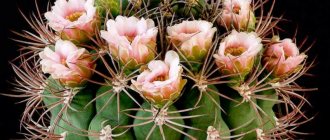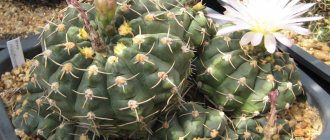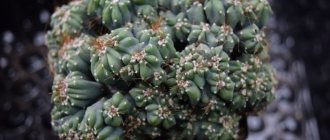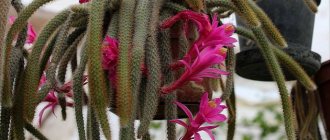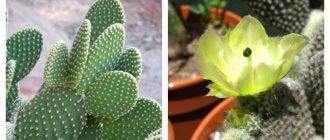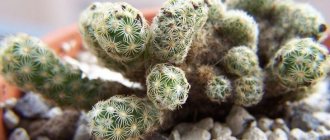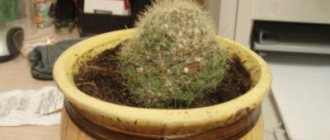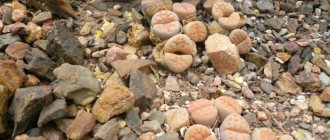Encyclopedia of Succulents
Cacti are prickly bushes that previously impressed almost no one. But now the fashion for these plants has become so popular that almost every gardener is ready to take on growing such crops. This is not surprising, because ease of care and attractive flowering do everything to make these plants become more and more popular. The Gymnocalycium cactus has an original appearance and incredible flowers. This article is devoted to the features of planting, caring for such a bush, as well as varieties of culture.
- 1 Description of the cactus genus Gymnocalycium
- 2 Gymnocalycium cactus: home care 2.1 Features of culture transplantation
Description of the cactus genus Gymnocalycium
The Cactus genus Gymnocalycium is a representative of the Cactus family (Cactaceae). Their distribution area is Argentina, part of Uruguay, Paraguay, part of Bolivia and Brazil. The name comes from the Greek words "gymnos", meaning "naked" and "kalyx", meaning "bud".
This crop is a perennial plant with a dense root system. Representatives of this genus are characterized by an incredible variety of shapes, shades, volumes of stems, and flowers. A large number of flattened balls are formed on the surface of the bush. The stem has a diameter of up to 0.15 meters, the height of the crop is up to 7 cm. The skin is in most cases glossy and has a dark green color. Under natural conditions, brown stains are observed on the surface of the stem.
Gymnocalycium in natural conditions
Flowering of bright bushes occurs in the period May-November. The buds are located at the top of the stem, which adds special charm and unreal beauty to them. The calyxes are closed, there are no spines on them, and there is also no pubescence. The flowers are usually bell-shaped with lanceolate-type petals. The petals can be colored in yellow, cream shades, and there are also variants of red and crimson tones. The flower reaches up to 7 centimeters in volume.
At the end of flowering, fruits with an ovoid configuration are formed on the bush. They are usually covered with minor scales. The length of the red, green or purple berry is up to 4 centimeters.
Types of Gymnocalycium
Gymnocalycium mihanovichii
Plant sale
Gymnocalycium Mihanovichii variegata
1900 rub. 2800 rub.
Gymnocalycium Mihanovich variegated
5300 rub.
Gymnocalycium Mihanovich variegated
4900 rub.
A charming little cactus from Paraguay. Gymnocalycium mihanovichii pleases with its interesting structure and spectacular flowering. It grows to approximately 4 cm in height and 6 cm in diameter. The plant forms a thick, spherical shoot, divided into triangular, deep, pointed ribs. Along the edges there are characteristic projections ending in large woolly white areoles from which sharp, hooked spines grow. The surface of the shoot is dark green, sometimes purple, and the edges of the ribs and notches are emphasized by a light creamy green edge. During flowering, large, beautiful light pink flowers appear at the tops of the stems.
Gymnocalycium andreae
It is a low, spiny cactus, barely rising above ground level, usually solitary in its habitat, but often branching at the base when cultivated, forming clusters 15 cm or more wide. This species differs from ordinary Gymnocalyciums in the color of its flowers, in this case a brilliant sulfur yellow.
Gymnocalycium baldianum
An unusual cactus native to mountainous and grassy areas of Argentina. Produces a spherical, slightly flattened shoot with a diameter of about 13 cm. The surface of the stem is divided into approximately 9-11 rather wide ribs of a dark green, black color, interrupted by shades of gray. The plant is additionally decorated with curved shining cream-colored spines. It is because of their shape and arrangement that Gymnocalycium baldianum is also called the “spider cactus”. In early summer, large, intense purple-red flowers appear on thick, upright stems. Refers to cacti valued for their expressive and abundant flowering.
Bruch's Gymnocalycium bruchii
It is a miniature succulent that grows in clusters when small. This species is very variable and has received many names. The stems are flattened, blue-green, thick, up to 4 cm in diameter, 6 cm long. The spines are white, bristly, straight or curved. Flowers: Bell-shaped to funnel-shaped, 6 cm wide, in early spring with an unusual shade of lavender-white, followed by green fruits. This slow-growing plant will eventually form clusters up to 15 cm in diameter. Depending on the length of the radial spines and their number, the following forms of this species are distinguished: Gymnocalycium bruchii f. niveum and Gymnocalycium bruchii f. albispinum.
Green Gymnocalycium (Gymnocalycium calochlorum)
A small, flattened cactus that forms low, flat clusters of many stems that grow at soil level. The spines are thin, mostly pinkish-brown. The light pink flowers are trumpet-shaped, over 5cm at their widest point. They don't open completely. The stem in its natural habitat is solitary to very lumpy, depressed-spherical, about 6 cm wide and 4 cm tall, shining pale green, gray-green or blue-green.
Gymnocalycium carminanthum
Best known in cultivation as Gymnocalycium carminanthum, it is a single stem species, small in size, with thick spines, slightly curved inward, which is especially attractive for its beautiful bright carmine-red flowers. It grows at altitudes between 1300 and 1800 m above sea level, but except for the color of the flowers it is the same as Gymnocalycium oenanthemum and is difficult to distinguish.
Gymnocalycium denudatum
A small, spherical, usually unbranched cactus with a glossy dark green body and rounded ribs. Gymnocalycium denudatum is extremely diverse. Stem: single, broadly globose, depressed, globose or hemispherical, 2-3 cm in height and 6-8 cm in diameter (up to 10 cm in height and 15 cm in diameter in cultivation), glossy gray-green to dark -green.
Gymnocalycium gibbosum
Small single cactus. This is a fairly variable species. This polymorphism has led some authors to describe many unnecessary varieties. Stem: Deep greyish green, olive green, brown to grey-black, discoid, lengthening over time 10-25 cm tall, up to 12 cm in diameter, apex slightly pubescent. Ribs: 10-16 straight, separated by well-defined angular ribs.
Gymnocalycium saglionis
A single barrel-shaped cactus, rather flattened, often very large, with long spreading and sometimes curved spines. They are a rich brown color and contrast nicely with the grey-green body. Stem: flattened globose to short cylindrical, more or less flattened to 30 (40) cm in diameter, 15-30 cm tall, sometimes up to 90 cm tall, dull green or blue-green. Vertex
Gymnocalycium cactus: home care
The first thing that is necessary for proper and comfortable growing of a plant is the optimal soil composition. The best soil is based on turfy, leafy soil, with a large amount of peat, sand and humus. All components are prepared and taken in equal proportions. Also, to improve the composition, you should add a little charcoal or brick chips to the mixture.
Photos of cacti Gymnocalycium Mihanovicha
The Gymnocalycium cactus prefers bright sunlight. It should be present on the windowsill in summer and winter. But remember that exposure to direct sunlight has a detrimental effect on the condition of the thorny bush.
It is also extremely important to maintain comfortable temperature conditions. In summer, an indicator of +21...24°C is suitable. When the warm period ends, it will be necessary to reduce the readings to +16°C. This type of cactus can withstand temperatures down to -5°C. Any air humidity is suitable; no additional spraying is needed.
To see blooming gymnocalyciums, they will need to choose the optimal watering. In spring and summer, this procedure is performed very carefully and sparingly. Remember the unspoken rule - the next watering is carried out only after the soil around the bush is completely dry. To moisten the composition, it is recommended to use water at room temperature, but always slightly settled. When summer is over, watering is carried out extremely sparingly.
Feeding also plays a big role. For fertilizer, it is better to use complex compounds suitable for cacti. Soil enrichment is carried out once a month. During the dormant period, no nutrients need to be added.
Features of culture transplantation
Proper care of the Gymnocalycium cactus also involves timely transplantation. It is recommended to perform this procedure once every 2-3 years. The optimal period for transplantation is spring. To complete the process, select a container that is larger than the previous one. It is better not to completely remove the earthen ball of the root system, but only superficially update the soil. When planting is carried out, the bush should be limited in watering. Irrigation is resumed only after 7 days.
Gymnocalycium Anisitsa
Growth:
Numerous populations of this cactus are scattered over a large area in Brazil, Bolivia and Paraguay (distribution area 25,000 km2). Gymnocalycium Anisitsa grows at an altitude of 70–400 m above sea level in open areas under the protection of low-growing leafless or few-leaved shrubs and is rarely found on rocks or sandy mountain areas. Receives diffused light. The soil in which this cactus grows is usually sand-rich loam. In summer it often rains in these places. The cactus often grows in groups and is very variable. There are no serious threats to the existence of this species.
The cactus is named after the Hungarian pharmacist and plant collector Dániel Anisits.
Description of the plant:
Plant size and type:
Gymnocalycium Anisitsa is a fairly easy-to-care cactus that blooms profusely with white or pink flowers. Can be single or branching. The spines are from 5 to 7, they are curved, up to 6 cm long.
Stem:
The stem is spherical-flattened to short cylindrical, 5–8 (up to 10) cm high and 8–10 cm in diameter, green or light green, acquiring a bronze tint in full sun, very decorative, often with horizontal light and dark stripes .
Ribs:
The ribs are from 8 to 11, they are sharp, with more or less pointed protrusions and tubercles.
Radial spines:
There are 5–7 radial spines, less often up to 9, they are straight or slightly curved, subulate, 1–6 cm long, located at an angle. Young spines are pastel white, yellowish or brownish in color with darker tips, becoming light gray with age.
Central spines:
Central spines are usually absent, sometimes there is only one.
Flowers:
The flowers are showy, funnel-shaped, usually greenish-white, but can be light pink or hot pink. The scales and outer tepals are wide, with greenish edges, the inner leaves are white, broadly oblong, pointed, with a greenish tint. The flower tube is thin.
IN THE PHOTO: Flowers of Gymnocalycium Anisitsa are usually white or pink.
Flowering period:
It can bloom almost continuously throughout the year.
Fruits and seeds:
The fruits are oblong, 2.5 cm long, 6–10 mm. in diameter, reddish when mature. The seeds are almost spherical, 1 mm in diameter, light brown, with an inconspicuous scar.
Varieties:
The species is very variable, there are many varieties of this cactus.
Gymnocalycium anisitsii subs. damsii
It is distinguished by reddish edges on the outer tepals, a pinkish tint on the inner tepals, and smaller scales on the ovary and on the floral tube.
Gymnocalycium anisitsii var. griseopallidum
It has a lighter, grayish-green stem with sharp ribs, greenish-white flowers, and small pink scales on the flower tube.
Gymnocalycium anisitsii subs. multiproliferum
This variety produces many shoots. Small babies appear on almost every areola, which are easily separated at the slightest touch and take root next to the main plant, forming colonies.
Gymnocalycium anisitsii var. tucavocense
This variety attracts attention with its purple flowers and flattened multi-colored stem. The stem is decorated with horizontal light and dark stripes ranging from light gray-pink to rich olive green and brown-violet. Seedlings sprout shoots and bloom, barely reaching a diameter of 1.5 cm.
The cultivar Gymnocalycium anisitsii var. tucavocense cv. Red Form with red stem.
All varieties have crested and monstrous forms.
Agricultural technology:
Gymnocalycium Anisitsa is a summer-growing and easy-to-care species. It grows relatively quickly and blooms easily.
Lighting:
The cactus tolerates very bright light well, but prefers diffused sun or shading during the midday. If grown indoors, it needs bright light and some direct sun. In bright light it takes on a bronze tint, blooms better and forms more powerful spines, but can get sunburned or grow stunted from excess direct sun on the hottest summer days.
Watering:
In summer, watering is moderate to abundant, but waterlogging should not be allowed, as the cactus is prone to rotting. Wintering is dry (minimum temperature 0°C).
Fertilizer:
In summer, the plant needs to be fed with high-potassium fertilizer.
Substrate:
Prefers loose standard cactus potting mix with low pH. The plant should not be planted in soil rich in limestone, otherwise it will stop growing. This Gymnocalycium needs a lot of space for roots, the cactus needs to be replanted every two years or when it outgrows its pot. Good drainage is necessary.
Rest period:
Gymnocalycium Anisitsa is frost-resistant and, if kept dry, can withstand short-term temperature drops to –5°C or lower. But the optimal temperature in winter is +8–10°C.
Diseases and pests:
The cactus may attract some pests, but if it grows in a mineral soil mixture, with good lighting and ventilation, then the plant is usually free of pests. However, it is worth paying attention to the following pests.
Red spider mite
They can be effectively destroyed by spraying the plant.
Mealybug
These pests can sometimes be found on young areoles, but it is worse if the scale insects reproduce on the roots, where they are not visible, but only the results of their activity are visible.
Shchitovka
The scale insect rarely attacks this cactus.
Rot
Gymnocalycium Anisitsa rarely suffers from fungal diseases. With proper watering and good ventilation, rot practically does not appear.
Reproduction:
By division or seeds.
Seeds are sown in the spring after the last frost. They germinate in 7–14 days at a temperature of +21–27°C. After about 1–2 weeks, when the seedlings have taken root well, the transparent lid from the container should be gradually removed in order to accustom the young plants to fresh air. Full sun is harmful to seedlings. When dividing Gymnocalycium Anisitsa, the shoot must be carefully broken off and allowed to dry for a couple of weeks, after which the cutting should be placed in the soil, its end slightly deeper. The cutting must be held vertically so that the roots grow downward. Editorial team LePlants.ru
How to propagate the Gymnocalycium plant
The Gymnocalycium cactus reproduces both vegetatively and by seed. A simpler method is propagation using lateral shoots. Once formed shoots will need to be unscrewed from an adult plant, left to dry for 24 hours, and then carefully planted in a sandy substrate. To strengthen the seedling, it is recommended to support it with matches. You can observe the appearance of the root system within a few days, provided that the procedure is performed in the spring. If such a process is carried out in winter, then additional illumination of the crop will be required.
This video shows the process of separating the side shoots of one of the types of Gymnocalycium
If Gymnocalycium seeds are used for propagation, then prepare a special container with a composition based on peat and sand. First, the mixture is placed in the oven so that it is well calcined. The seed material is carefully laid out on the soil, then lightly covered with soil. The container is covered with cling film when it is removed after the seedlings emerge. Be sure to ensure that the soil does not dry out. If you adjust the air temperature to +20°C, you can observe the first shoots after 10-12 days. It is recommended to replant the bush only after 1 year.
Note! The cactus Gymnocalycium Mihanovicha is propagated by grafting. It can be grafted onto any other green, thorny crop. A horizontal cut is made on the rootstock, and the same is done with the scion. The specimens are pressed securely and fixed with a bandage that has a certain weight. After 7 days the bushes grow together.
